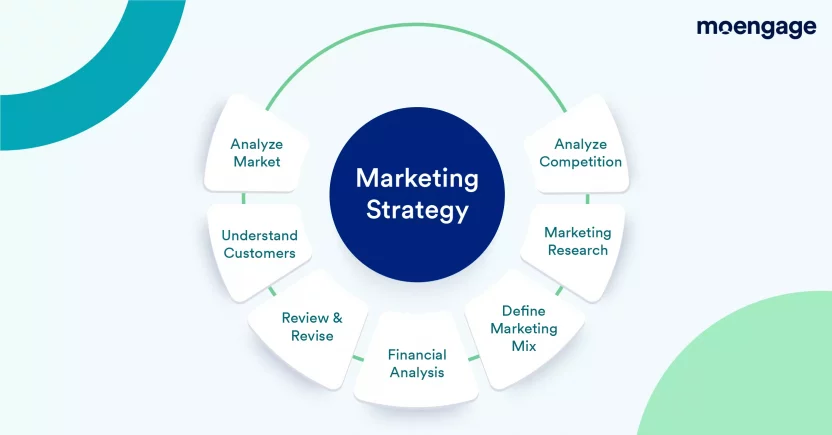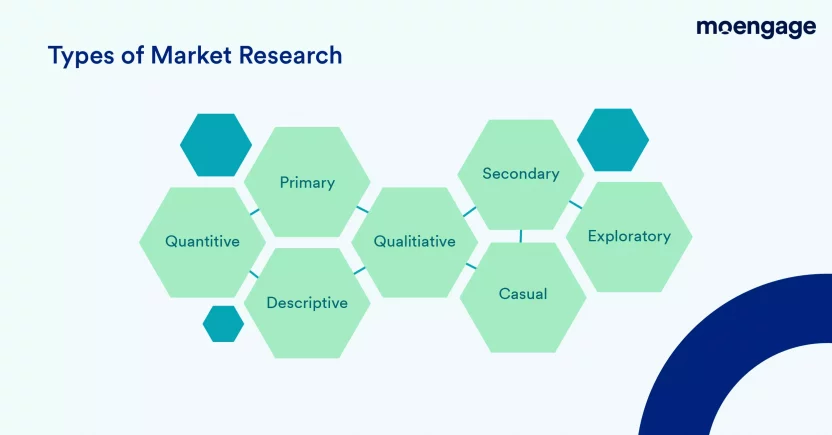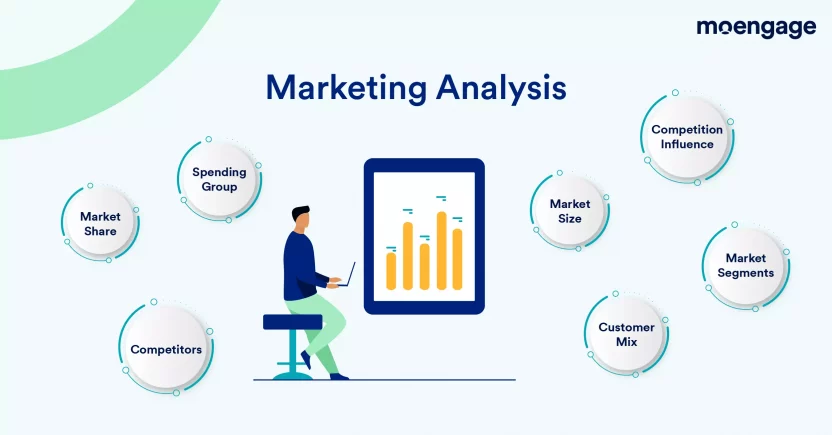Different Types of Marketing Analysis (and Things You Should Know)
Different types of marketing analysis and how it will help your organization

Reading Time: 9 minutes
No matter the size of your organization, conducting market research or even understanding the different types of marketing analysis is necessary for success. But how do you conduct market research?
How much of the market analysis should be based on customer data?
What are the different ways of using these actionable insights?
You can include qualitative research and quantitative research methods, as it will help gauge market trends, product-market fit, and even customer satisfaction and retention data.
But here’s the catch, market analysis is an ongoing process, and marketers might have to conduct market research on a timely basis to stay relevant to their customers.
For example, in MoEngage’s customer engagement maturity index, we have conducted our own market research and analysis into the different martech tools, personalization, and customer segments, and the different channels preferred as well as the insights used (customer behavior, journey, and campaign).
| Find Your Customer Engagement Maturity Score
👉Check your customer engagement maturity score against your competitor |
What are the Different Types of Market Research?
Let’s start with the basics:
- Primary research: This type of market research is conducted when you are looking for information from a particular set of customers. The only thing, you are directly reaching out to them! This is mostly done with the help of surveys or with focus groups. The best part, since the data is created by you, the data collection is yours.
- Secondary research: Usually a market research firms conducts surveys and research to collect data which can be used to analyze new markets, or even product market fit. Since the raw data has been previously collected, its the market research firm that owns the data set.
- Qualitative research: In this method, you collect and analyze non-numerical data to acknowledge a concept, opinion or even customer experiences based on the market analysis.
- Quantitative research: The process of collecting numerical data that can be used to find patterns, and missing gaps is what is known as quantitative research.
- Customer research: Want to understand what your customer likes or prefers? This market research method helps to understand what works for particular customer segments. This market research takes into account customer satisfaction, customer loyalty, and even historical data points to help you improve sales volume.
- Competitor research: Most marketing teams conduct competitive analysis to gauge the strengths and weaknesses of their competitors. This helps to gain insights into product, sales and marketing tactics and adopt marketing strategy that works best!
- Brand research: Curate your brand’s value with brand research. This type of market research will help you understand who knows your brand, what is the general perception of the brand, and customer loyalty towards the brand.
What is the General Use of Market Analysis in a Marketing Strategy?

How can market analysis help in developing a marketing strategy
The right market analysis focuses on customer behavior and market trends to understand customer psychology and buying patterns.
The right kind of market analysis also helps you to understand how the customers perceive your business and how satisfied they are with your offering and help reveal any hidden marketing opportunities.
Benefits of Market Analysis
- Understanding customer behavior and buying pattern
- Identify hidden opportunities
- Understanding which distribution channel works and gives a competitive advantage to the brand
- Understanding customer needs
- Gauge the value proposition of the product
Types of Marketing Analysis and How Can it Help a Business?

The different types of market research that a brand can conduct
Descriptive Analytics
In this analytics, you use real-time and historical data to understand the “what happened” part.” It analyzes your brand’s present situation and where you want to be in the future. It takes a deep dive into your demographic data and customer data to gauge what worked the best and what didn’t.
One of the easiest examples to understand descriptive market analytics is if your organization is analyzing your customer engagement either via website traffic or even social media analytics. The marketing team can use the data points to understand the source of the traffic and even customer engagement.
Predictive Analytics
While descriptive analysis examines what happened in the past, predictive analytics aims to predict what might happen in the future. Predictive analytics answers things for the future, taking cues from insights found during a descriptive analysis process. However, predictive analytics can’t guarantee a 100% accurate result. It analyses past data and makes a data-driven prediction about the probability of occurrence of a certain event.
Sentiment Analysis
Apart from descriptive and predictive analytics, another market analysis that helps you understand how your target audience feels and perceives your brand is sentiment analysis.
Sentiment analysis is one parameter that helps you gauge your customers’ sentiments towards your company’s products or even your brand. Simply put, when your customers share a positive sentiment about your brand, they are likely to buy from you. They are most likely to show brand loyalty, while a negative sentiment means churn and resorting to your competitor for business.
You can tap into customer reviews and customer feedback along with social media responses to gauge your customer feelings and categorize them as positive, neutral, and negative responses. These data can have a strong impact on the entire process of your product marketing.
Competitive Analysis
Before beginning any marketing campaign, you need to analyze your competitors’ actions. That’s what competitor analysis does for you.
Knowing your competitors’ strengths, weaknesses, and gaps in their offerings can play a crucial role in your brand positioning. Plus, you will be aware of any strategic change in the competitor’s marketing tactic and be prepared for your next move.
Customer Decision Journey
Studying the customer decision journey can help you determine what a customer decision journey looks like, what factors influence a customer’s decision journey, how customers choose between two competing products, and whether the existing products in the market can meet their demands.
A deep analysis of all these factors can help you determine how to impact the decision journey by using the right channel and strategy mix to market your product.
Pricing
Pricing is an important part of your market analysis. It helps you understand the optimized market price for your product. It also gives you market knowledge and actionable insight into what features customers desperately want and are willing to pay any price for them vs. redundant features that customers won’t pay for.
The insights can help you shape your pricing plan — especially a tiered pricing plan based on your audience categories and the kind of features they would pay for. Whether you are setting the price for a new product or optimizing the product price for an existing product, pricing is a crucial factor for marketing analysis.
Brand Awareness
Brand awareness means how familiar your target audience is with your brand. It is a good way to measure customer loyalty. Measuring brand awareness as a part of your marketing analysis helps you to identify the buyer’s intent. For example, if your solution is a productivity tool, how likely will the customer to recall your brand name when they decide to invest in a productivity tool? Is your name coming to the top of their mind?
Marketing Message Testing with Focus Groups
Your target audience comes across hundreds of marketing messages every day. How likely is it they will read your message?
You figure that out by conducting message testing and market analysis. Pick a few focus groups and ask them to recall your last message. If they can recall, try to understand the degree of their recall. Ask questions like, were they triggered by the message to take action?
Market Segmentation
Market segmentation is important as it gives you insight into the customer demographics, attitude, behavior, and needs. Doing market segmentation helps you focus on the marketing strategy you can customize for each targeted group.
Product Development
Product development research is a handy tool to use while planning to add new product verticals or modify a product in your existing product suite. A thorough product development research will help you to find answers to many questions like:
- What your customers want
- How can you improve your existing product
- If you should introduce a new product
- What new product will the customer be interested in
What are the Components and Techniques of Marketing Analysis?
Many of your efforts go into research and gathering data before marketing analysis.

Different components include:
-
Customer Description
Customer description helps you to know the demographics of your customers. You can segment the demographics of your target audience in several ways, including buying habits, income, etc. Knowing the demographics of your customers can help you decide on your marketing tactics and adopt tactics that can trigger them to take action.
-
Customer Perception
Customer perception is nothing but how your customer sees and evaluates your brand. Measuring what marketers conduct through surveys or focus group interviews is important. The deep insights you derive from this analysis will help you understand your brand awareness, brand recognition, and how likely your customers will buy from you. Do they think you as a trusted brand? Are you always on top of your mind when a buying need arises?
-
Market Trends
Market trends analysis demonstrates the relevance of your product in the current market situation. You can do a PEST analysis ( Political, Economic, Social, and Technological) to understand the market trends. Market research also lets you identify future market opportunities.
-
Market Projections
It takes information from market trends, brand perception, and descriptions and trends to forecast how the target market will be in the future, along with how your business will respond to the market. This analysis helps you to target areas that need more focus in the coming days. It also helps the business to succeed by making suitable recommendations.
-
Competition
Finally, another aspect of measuring is the competition in your business. During a competitor analysis, you may want to analyze how your target audience perceives the competitor’s brand, how the market trend is affecting the competitor’s brand, and how the changing marketing dynamics and key drivers can affect the competitor’s brand in the future.
A Step-by-Step Guide to Conducting a Market Analysis
Doing a marketing analysis is not difficult, but you need the correct approach to get the best marketing information that can address your customers’ pain points and help you stay ahead in your specific market. Here is a step-by-step guide to help you navigate the process better.
Determine Your Purpose
Different organizations do marketing analyses for different purposes. For example, some brands may want to do it because they want to foray into a new domain and want to analyze the market. Some brands might want a competitor analysis before launching a new product line. So, define your purpose before you begin doing marketing analysis.
Research the State of the Industry
Create a map of the present state of the industry. Jot down everything that you think is relevant. For example, is the industry growing? Where do you predict to see the industry heading? A comparative analysis is a good way to determine if your brand has a competitive advantage in the industry.
Identify your Target Customer
Your product is certainly not made for everyone. And it would be a waste of effort to target everyone as your audience. So identifying your target customer is essential to tailor-make your marketing campaigns. While analyzing your target customer identify their gender, where they come from, age, needs and interests, education, profession, etc.
Understanding the Competition
While understanding the market, industry, and target audience is important, you must also deeply understand your competition. Make a list of all your competitors, rank them and do a SWOT analysis of your direct competitors.
Gather Data – More the Merrier
No analysis is complete until you have gathered sufficient data to support your assumptions as accurate. You also need to analyze the data to make data-driven decisions. So gather data that can help you understand the buying preference of your target customers, give you an overview of the industry, help you forecast your growth, for which products/features customers are willing to pay more, and so on.
What Market Dimensions Should one Consider?
Market analysis is important for any business to understand its present position and future potential. However, various internal and external factors can affect the dimensions of market analysis. The different dimensions that one should consider are:
- Target audience analysis
- Environmental analysis
- Competitive analysis
- SWOT analysis
- Environmental issues
- Competitive positioning
How can a Customer Engagement Maturity Index be the Most Critical Marketing Analysis Tool?
The customer engagement maturity index compares various aspects of customer engagement, including tools and platforms in the Martech stack, engagement strategies, personalization, and channels used, and the different insights used, like customer journey, campaign, etc.
Using MoEngage’s customer engagement maturity index tool, you can measure how mature your customer engagement is compared to your competitors.

The tool measures six capabilities:
- Analysis and Prediction: It analyses your engagement tech stack and the kind of customer insights you are measuring. It also measures the customer journey and your campaign at each stage.
- Personalization: Take any form of marketing, and personalization is the core of it. It’s a no-brainer that more personalized communication is bound to see better traction than communication that is random and not personalized. This capability measures your personalization efforts regarding customer communication, the conditions, and the channels used.
- Engagement and Retention: Are your customers engaged with your brand? Engagement and retention go hand in hand (better engagement = better retention chances), so this is an important metric to measure.
- Omnichannel Strategy: As the name suggests, this metric focuses on your omnichannel strategy, the channels involved, and how you prioritize them in your marketing efforts.
- Mobile and Digital Strategy: Having a strong mobile and digital strategy is important if you want your brand to be omnipresent. This capability helps you to measure your digital strategies in terms of usage across the web, social, email, and mobile, among others.
- Resources and Operations: How well are you managing your resources and operations? Because your ROI depends on it. Measuring this capability lets you analyze if you are optimizing your resources and operations
Here’s What You Can Read Next
|















